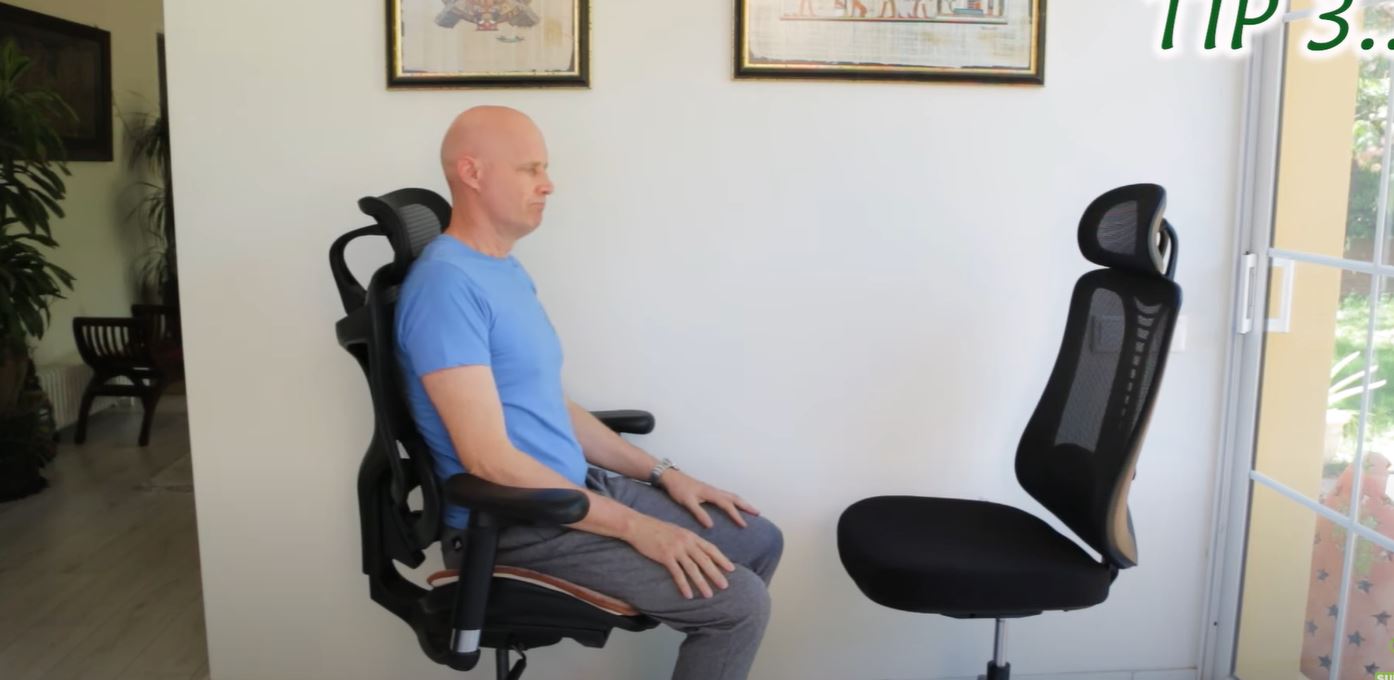If your job requires you to spend long hours sitting at a desk, your office chair is arguably the most critical piece of furniture you own.
It’s more than just a place to sit; it is a vital tool that dictates your posture, comfort, and, ultimately, your long-term health.
Choosing the right one is essential for turning those hours into productive, pain-free work sessions.
Why Ergonomics Matters in Office Chairs
The human body is designed for movement, not for remaining static in a 90-degree angle all day. When you use a poorly designed chair, your body is forced into unnatural positions. Ergonomics is the science of designing the workplace to fit the user, and when applied to chairs, the benefits are profound.
- Supports Spinal Health: An ergonomic chair maintains the natural “S” curve of your spine, especially the inward curve of your lower back (the lumbar region). This prevents slouching and excessive strain on the disks and ligaments.
- Reduces Fatigue: By supporting your body in a neutral posture, the chair takes the load off your muscles. This means less energy is spent on maintaining an upright position, drastically reducing muscle fatigue in the back, neck, and shoulders.
Prevents Long-Term Damage: Consistent use of a non-ergonomic chair can lead to musculoskeletal disorders (MSDs), chronic back pain, and issues like sciatica or carpal tunnel syndrome. A good chair is a powerful preventative measure against these occupational health risks.
Key Features of an Ergonomic Office Chair
The core difference between a standard chair and a truly ergonomic one lies in its adjustability. A good chair can be customized to fit your unique body dimensions perfectly.
Adjustable Seat Height
Proper seat height is the foundation of an ergonomic setup, as it aligns your entire lower body.
- Customization: The height should be easily adjustable (usually via a gas lift or hydraulic system) to ensure your feet can rest flat on the floor.
- Knee Angle 90 Degrees: When your feet are flat, your thighs should be parallel to the floor, and your knees should be bent at a comfortable 90-degree angle, or slightly more. This positioning ensures healthy circulation to your legs and feet.
Lumbar Support
The lumbar region (lower back) is where most seated strain occurs; dedicated support here is non-negotiable.
Lower Back Alignment: The chair must have a built-in lumbar support system that can be positioned to fit the natural curve of your lower back.
Adjustability is Key: The best chairs offer adjustable lumbar support (both height and depth) so you can precisely place the cushion in the small of your back. This ensures your spine is supported whether you are leaning forward slightly or sitting back fully.
Seat Depth and Width
The seat pan must support your entire thigh while preventing pressure behind the knees.
- Proper Thigh Support: The seat should be deep enough to support most of your thighs, but you must still be able to fit 2 to 3 fingers (about 2-3 inches) between the front edge of the seat and the back of your knees.
- Circulation: If the seat is too deep, it can cut into the back of your knees, constricting blood flow. If it is too shallow, it won’t provide adequate support.
Seat Width: The width should be wide enough (typically 17–20 inches) to comfortably accommodate your hips and thighs without being restrictive.
Armrests
Armrests should primarily function to relieve strain from your neck and shoulders.
- Angle Positioning: Armrests must be adjustable for height. When your arms are resting, your shoulders should be completely relaxed, and your elbows should be bent at a 90-degree angle, allowing your forearms to rest parallel to the floor (and aligned with your desk height).
- Padded and Soft: Choose armrests that are padded to prevent discomfort and nerve compression in the elbows.
- Desk Alignment: The armrests should allow you to pull the chair close to your desk without hitting it, which is why flip-up armrests are an excellent feature for space management.
Backrest Tilt and Recline
Movement, even micro-movements, is crucial for blood flow and muscle relaxation.
- Tilt Tension: The backrest should recline easily and allow you to adjust the tilt tension to match your body weight, so you can lean back without falling backward.
- Reclining Angle: The ability to recline allows you to change positions throughout the day. Many experts recommend a slight recline (between 100∘ and 110∘) for typing, as this position removes pressure from the spine more effectively than a perfect 90∘ angle.
Headrest Options
A headrest is most useful for resting or reclining but is not strictly necessary for upright work.
- Neck Support: If you spend time reclining or taking calls in your chair, an adjustable headrest can provide vital support for the cervical spine (neck), reducing tension and preventing upper back pain.
- Adjustability: Ensure the headrest can be adjusted both vertically (height) and horizontally (angle/depth) to meet the natural curve of your neck while maintaining a neutral head position.
Swivel and Mobility
Movement capability ensures efficiency and prevents unnecessary strain from twisting.
- 360-Degree Rotation: A swivel base allows you to access different parts of your desk (or multiple monitors) without twisting your torso, protecting your spine.
- Smooth Casters: The chair should have five strong casters (wheels) that roll smoothly and silently on your specific floor type (hardwood, carpet, etc.) for convenient mobility.
Materials and Build Quality
Beyond adjustability, the materials used in an ergonomic chair are crucial for determining its longevity, comfort, and maintenance needs.
Mesh vs. Leather Chairs
The choice of upholstery affects both comfort and aesthetics.
- Mesh (Best for Breathability): Mesh fabric offers superior breathability by promoting airflow between your body and the chair. This is ideal for long work sessions, especially in warmer environments, as it prevents heat and sweat buildup. Maintenance is generally easier, but some cheap mesh fabrics may lose elasticity over time.
- Leather/PU Leather (Best for Durability and Aesthetics): Leather (or high-quality polyurethane leather) offers a classic, professional aesthetic and is highly durable. It’s easy to wipe clean, but it lacks the ventilation of mesh, meaning it can get warmer during long periods of sitting.
Cushioning and Padding
The comfort of the seat pan depends heavily on the foam used.
- High-Density Foam: This is the standard for quality ergonomic chairs. It is firm enough to provide support and stability but will conform slightly to your body. High-density foam retains its shape and prevents the “bottoming out” feeling that occurs with cheap, low-density foam.
- Memory Foam/Gel: Often used as a top layer, memory foam provides superior pressure relief by distributing your weight evenly, enhancing comfort during long-term use.
Frame and Base Materials
The core structure dictates the chair’s stability and maximum weight capacity.
- Steel/Aluminum: These metals are used in high-end chairs for the frame and base, offering superior strength, stability, and durability. They are the materials of choice for reinforced, high-weight-capacity chairs.
- Heavy-Duty Plastic/Nylon: Used in many mid-range chairs, quality nylon or plastic bases are strong and lighter than metal but may not offer the same long-term resilience or weight support as a metal frame.
Choosing a Chair Based on Body Type
No single chair fits everyone. True ergonomics requires matching the chair’s dimensions to the user’s physique.
Chairs for Short People (Petite Ergonomic Chairs)
Shorter individuals often struggle to meet the foundational goal of having their feet flat on the floor.
- Lower Minimum Height: Look for chairs with a seat height that adjusts to a lower minimum setting (often 16.5 inches or less).
- Shallower Seat Depth: A shallower seat depth is crucial to maintain the 2-3 inch gap behind the knees. If the seat is too deep, the user is forced to slouch forward.
- Footrest Use: If the optimal chair height is still too high, an adjustable footrest is necessary to maintain the 90∘ knee angle and proper circulation.
Chairs for Tall People (Big and Tall Chairs)
Taller individuals need extended range in all dimensions.
- Extended Seat Depth: Taller users need a deeper seat pan to ensure adequate thigh support. Some premium chairs offer adjustable seat depth (forward/backward slide).
- Higher Backrest and Headrest: The backrest must be tall enough to support the user’s upper back and shoulders. If the chair has a headrest, ensure it can be adjusted high enough to truly support the neck, not just the shoulders.
- Higher Maximum Height: The gas lift needs a higher maximum extension to ensure the 90∘ knee bend is achieved when sitting at a tall desk.
Chairs for Heavy Weight Capacity
Safety and durability are the primary concerns for heavier users.
- Reinforced Frames and Wider Base: Look for chairs specifically rated as “Big and Tall” with reinforced frames made of heavy-duty steel or aluminum.
- Higher Weight Rating: These chairs typically offer support for 300 lbs up to 400+ lbs. They feature wider seats and thicker padding to distribute pressure effectively and provide reliable stability.
Price vs. Value
Ergonomic chairs span a wide price spectrum, but value is determined by longevity, feature set, and warranty.
- Budget ($100–$250): These chairs may offer basic adjustability (height, tilt) and mesh backs but often compromise on component quality (e.g., cheaper plastic frames, lower-density foam). They are best for occasional use.
- Mid-Range ($250–$500): This range hits the sweet spot for home offices, offering better build quality, adjustable lumbar support, and more robust gas lifts. Look for good brand warranties here.
- Premium ($500+): These are investment pieces known for high-quality materials (aluminum, high-density specialized foam), extensive adjustability (4D arms, seat depth slide), and long warranties (5–12 years) from top brands. They offer the best long-term health return.
Popular Ergonomic Chair Brands to Consider
The market has several reputable brands known for their commitment to ergonomics and durability.
- Herman Miller: Known for premium, high-design chairs (e.g., Aeron, Embody) that offer unparalleled ergonomics and long-term warranties (often 12 years).
- Steelcase: Another leader in the premium market, known for outstanding durability, build quality, and innovative features (e.g., Gesture, Leap). Excellent for heavy, all-day use.
- Branch: A newer brand popular for providing high-quality, fully featured ergonomic chairs at a competitive mid-to-high price point, balancing features and value.
- Secretlab: Highly popular in the gaming and office space, known for their Titan and Omega series, which offer supportive, comfortable seating with a focus on strong lumbar support and durable materials.
- IKEA: Offers budget-friendly entry points (e.g., Markus, JÄRVFJÄLLET). While less adjustable than premium brands, they provide better support than basic chairs at an accessible price.







